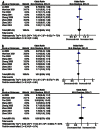The C825T polymorphism of the G-protein β3 subunit gene and its association with hypertension and stroke: an updated meta-analysis
- PMID: 23799054
- PMCID: PMC3682991
- DOI: 10.1371/journal.pone.0065863
The C825T polymorphism of the G-protein β3 subunit gene and its association with hypertension and stroke: an updated meta-analysis
Abstract
Objective: Several epidemiological studies have evaluated the association between the GNB3 C825T polymorphism and hypertension or stroke. The results of these studies were inconsistent; therefore, we performed a meta-analysis to clarify these discrepancies.
Methods: We systematically searched the PubMed, Embase, Web of Science, CNKI, and CBM databases, and manually searched reference lists of relevant papers, meeting abstracts, and relevant journals. Pooled odds ratios (ORs) and 95% confidence intervals (CIs) were calculated for dominant, recessive, and allelic models. A fixed or random effects model was separately adopted depending on study heterogeneity. Subgroup and sensitivity analyses were performed to detect study heterogeneity and examine result stability, respectively. Publication bias was tested using funnel plots, the Egger's regression test, and Begg's test.
Results: We screened 66 studies regarding hypertension and eight concerning stroke. A combined analysis showed that only the allelic model found a marginal association with hypertension (OR = 1.07, 95% CI = 1.01-1.13) and female gender (OR = 1.11, 95% CI = 0.99-1.24). However, no comparison models found an association with stroke (allelic model: OR = 1.11, 95% CI = 0.94-1.32; dominant model: OR = 1.16, 95% CI = 0.92-1.48; and recessive model: OR = 1.05, 95% CI = 0.97-1.14). Sensitivity analysis suggested that all models did not yield a relationship to hypertension or stroke among Asians. Besides, there was a lack of statistical association with hypertension in Caucasians, which maybe due to a small sample size. When we restricted the included studies to normal populations according to the Hardy-Weinberg equilibrium, no association was found.
Conclusions: There was no evidence indicating that the 825T allele or TT genotype was associated with hypertension or stroke in Asians or hypertension in Caucasians. However, further studies regarding Africans and other ethnicities are needed to identify further correlations.
Conflict of interest statement
Figures





Similar articles
-
A meta-analysis of the relationship between MTHFR gene A1298C polymorphism and the risk of adult stroke.Cerebrovasc Dis. 2014;38(6):425-32. doi: 10.1159/000369122. Epub 2014 Dec 3. Cerebrovasc Dis. 2014. PMID: 25472665
-
Association between polymorphism of the G-protein β3 subunit C825T and essential hypertension: an updated meta-analysis involving 36,802 subjects.Biol Res. 2013;46(3):265-73. doi: 10.4067/S0716-97602013000300007. Biol Res. 2013. PMID: 24346074 Review.
-
Association of α-adducin and G-protein β3 genetic polymorphisms with hypertension: a meta-analysis of Chinese populations.PLoS One. 2011 Feb 25;6(2):e17052. doi: 10.1371/journal.pone.0017052. PLoS One. 2011. PMID: 21364877 Free PMC article.
-
Lack of an association between CYP11B2 C-344T gene polymorphism and ischemic stroke: a meta-analysis of 7,710 subjects.PLoS One. 2013 Aug 8;8(8):e68842. doi: 10.1371/journal.pone.0068842. eCollection 2013. PLoS One. 2013. PMID: 23950878 Free PMC article.
-
Meta-analysis of the genetic association between maternal GNB3 C825T polymorphism and risk of pre-eclampsia.Int J Gynaecol Obstet. 2021 Sep;154(3):385-392. doi: 10.1002/ijgo.13560. Epub 2021 Jan 18. Int J Gynaecol Obstet. 2021. PMID: 33368205 Review.
Cited by
-
Cardiovascular diseases-related GNB3 C825T polymorphism has a significant sex-specific effect on serum soluble E-selectin levels.J Inflamm (Lond). 2016 Dec 9;13:39. doi: 10.1186/s12950-016-0146-z. eCollection 2016. J Inflamm (Lond). 2016. PMID: 27990099 Free PMC article.
-
Zinc Finger 259 Gene Polymorphism rs964184 is Associated with Serum Triglyceride Levels and Metabolic Syndrome.Int J Mol Cell Med. 2016 Winter;5(1):8-18. Int J Mol Cell Med. 2016. PMID: 27386434 Free PMC article.
-
G-Protein β3-Subunit Gene C825T Polymorphism and Cardiovascular Risk: An Updated Review.High Blood Press Cardiovasc Prev. 2015 Sep;22(3):225-32. doi: 10.1007/s40292-015-0093-4. Epub 2015 Apr 23. High Blood Press Cardiovasc Prev. 2015. PMID: 25903425 Review.
-
Genetic variants of accessory proteins and G proteins in human genetic disease.Crit Rev Clin Lab Sci. 2025 Mar;62(2):113-134. doi: 10.1080/10408363.2024.2431853. Epub 2025 Jan 1. Crit Rev Clin Lab Sci. 2025. PMID: 39743506 Free PMC article. Review.
-
Analysis of HCRTR2, GNB3, and ADH4 Gene Polymorphisms in a Southeastern European Caucasian Cluster Headache Population.J Mol Neurosci. 2020 Mar;70(3):467-474. doi: 10.1007/s12031-019-01439-0. Epub 2019 Nov 25. J Mol Neurosci. 2020. PMID: 31768945
References
-
- Kuo TY, Kang MJ, Chen JW, Ho HY, Ting CT, et al. (2012) A two-stage matched case-control study on multiple hypertensive candidate genes in Han Chinese. Am J Hypertens 25: 804–811. - PubMed
-
- Dichgans M (2007) Genetics of ischaemic stroke. The Lancet Neurology 6: 149–161. - PubMed
-
- Siffert W (2005) G protein polymorphisms in hypertension, atherosclerosis, and diabetes. Annu Rev Med 56: 17–28. - PubMed
-
- Klenke S, Kussmann M, Siffert W (2011) The GNB3 C825T polymorphism as a pharmacogenetic marker in the treatment of hypertension, obesity, and depression. Pharmacogenet Genomics 21: 594–606. - PubMed
Publication types
MeSH terms
Substances
LinkOut - more resources
Full Text Sources
Other Literature Sources
Medical

